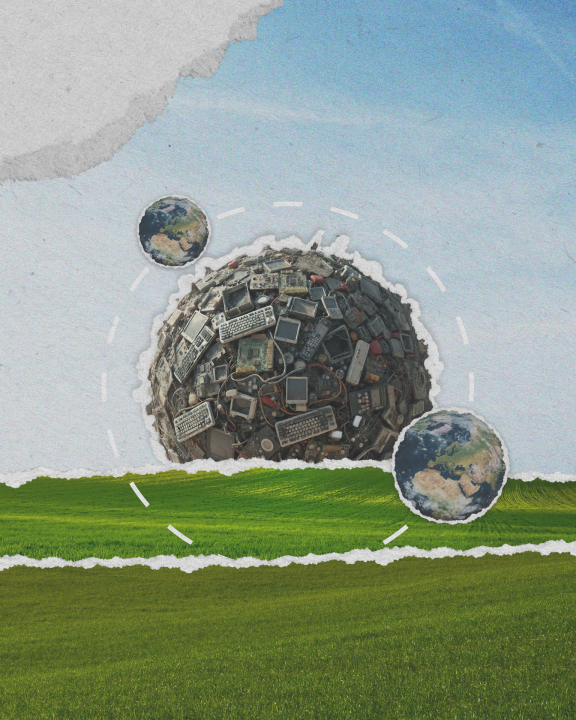
Your choices do matter when it comes to e-waste
In the grand scheme of environmental problems, it’s tempting to think ‘my actions don’t matter’. But we beg to differ. When it comes to e-waste, your personal choices can make a real difference. We crunched the numbers on the (environmental and financial) impact you can have by making sure electronics don’t go to waste. Turns out your impact might be bigger than you thought.
The problem with e-waste
Our hunger for the latest tech is fuelling one of the fastest-growing waste streams in the world: e-waste. Right now, only 17% of e-waste is properly recycled. The rest often ends up in landfills where toxic components leach into soil and water, while valuable resources – extracted at high human and environmental cost – are being lost.
Meanwhile, production of new tech is five times higher than recycling rates, so the e-waste pile just keeps growing.
You’re in charge of the story
You can’t change your electronic device’s past – it may be very old, broken or perhaps it’s still good – but you can influence its story from today on. Whatever you do, making sure it ‘lives on’, whether as a device or in a new recycled state, is always a good idea.
That old device you haven’t used in a year
We’ve all got one: that forgotten phone in a drawer somewhere. Letting it gather dust helps no one. There are way better options for both your pocket and the planet. Even if that device is broken!
- A very old or broken smartphone still sells for an average of €69 on OLX resell platforms
- If your phone still works, using it for one extra year saves you €84. Reselling it earns you €161. Simultaneously you help the buyer save €257 compared to buying new, even after factoring in that second-hand devices have a shorter lifespan.
- Together, you and the buyer save 36 kg of CO2e, equal to driving 300 km in a petrol car.
The bigger the device, the bigger your impact. You earn €237 on average by selling your laptop and you help the buyer save €923. Together, you cut 121 kg of CO2e-emissions*, roughly equal to 900 kilometres by mid-sized petrol car.
Part of a bigger picture
Now, you might think ‘300 km of car emissions for a smartphone isn’t that much. It’s not worth it, I’ll leave that phone in the drawer.’ But imagine 10 people thinking the same thing. That’s 3,000 kilometres now being cut. Or 1,000 people. That’s 300,000 kilometres.
Now scale it up to 2 million people – the total number of smartphones sold on OLX platforms in 2024. That’s 600 million kilometres by mid-sized petrol car prevented by the whole lot of you. Individual actions, added together, generate massive impact.
Solving e-waste takes all of us
With every smartphone sold, refurbished or properly discarded for recycling, 165 grams of materials are diverted from the landfill. For every tablet, that’s 660 grams, for a laptop 1.5 kg and for a TV even 22.5 kg.
Now, we don’t want to portray e-waste solely as a consumer problem. It’s a culmination of weak waste management and regulation, producer reluctance and consumer action.
There should be proper infrastructure for people to deal with their e-waste properly, and this should be enforced by rules and regulations. To fix it:
- Governments need to promote legislation and invest in proper recycling infrastructure.
- Manufacturers should design for repair, reuse, and material recovery.
- Consumers should resell, repair, or recycle devices responsibly.
And that last point, that’s where you come in. So, yes. Your choices do matter. On their own, and even more as part of a community making the right calls.
*How were these impact savings calculated?
We measured the full ‘cradle-to-grave’ impact of producing electronics: from resource extraction to manufacturing, transport and waste treatment.
The prevented impact of second-hand electronics is then calculated using the lifespan extension method: instead of assuming every resale prevents a brand-new device, we – more conservatively – assume production, transport and waste treatment is postponed by a few years. So, a certain percentage of the lifecycle impact is saved, not the entire impact.
Example: a 4-year-old laptop is resold and used for another 3 years. That extends the lifespan by 75%, so 75% of a new laptop’s lifecycle impact is avoided.

In a former life Nina was circular economy advisor. She was missing a creative touch in her life, so she turned to copywriting instead. Then she was missing a sustainability touch in her life, so she combined the two. Now she's a sustainability advisor who writes, or - if you will - a writer who gives sustainability advice. She does this with her own company New Alchemists.
Nina helped setup Rethink Things. Together with the Rethink Team, she developed our strategy, branding, website, socials, newsletters, you name it. Today, she continues to write for the platform.














